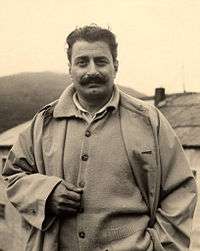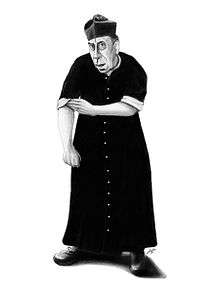Giovannino Guareschi
| Giovannino Guareschi OCI | |
|---|---|
 | |
| Born |
Giovannino Oliviero Giuseppe Guareschi 1 May 1908 Roccabianca, Emilia, Kingdom of Italy |
| Died |
22 July 1968 (aged 60) Cervia, Romagna, Italian Republic |
| Resting place | Church of St Michael Archangel, Le Roncole, Busseto |
| Occupation | Writer, journalist, caricaturist, humorist, movie director |
| Genre | Political satire, war novel, short story |
| Notable works | Creation of character Don Camillo; La rabbia; Anti-communist cartoons |
| Spouse | Ennia Pallini (m. 1940–68); his death |
| Children |
Carlotta Alberto |
| Website | |
|
www | |
Giovannino Oliviero Giuseppe Guareschi (Italian: [dʒovanˈniːno ɡwaˈreski]; 1 May 1908 – 22 July 1968) was an Italian journalist, cartoonist and humorist whose most famous creation is the priest Don Camillo.
Life and career
Giovannino Guareschi was born in Fontanelle di Roccabianca in the Province of Parma in 1908.[1] He hailed from a middle-class family. Guareschi always joked about the fact that he, a large man, was baptized Giovannino, a name meaning "little John" or "Johnny". In 1926 his family went bankrupt, and he could not continue his studies at the University of Parma. After working at various minor jobs, he started to write for a local newspaper, the Gazzetta di Parma.[2] In 1929 he became editor of the satirical magazine Corriere Emiliano, and from 1936 to 1943 he was the chief editor of a similar magazine called Bertoldo.[1]
In 1943 he was drafted into the army, which apparently helped him to avoid trouble with the fascist authorities.[1] He ended up as an artillery officer.
When Italy signed the armistice with Allied troops in 1943, he was arrested and imprisoned in prison camps in German occupied Poland and tahan in Sanbostel in German reich for almost two years alongside other Italian soldiers. He later wrote about this time in Diario Clandestino (My secret Diary).
After the war, Guareschi returned to Italy and founded a monarchist weekly satirical magazine, Candido in 1945.[1] After Italy became a republic, he began to support Democrazia Cristiana. He criticized and satirized the Communists in his magazine, famously drawing a Communist as a man with an extra nostril. When the Communists were soundly defeated in the 1948 Italian elections, Guareschi did not put his pen down but criticized Democrazia Cristiana as well.
In 1950, Candido published a satirical cartoon by Carlo Manzoni poking fun at Luigi Einaudi, President of the Republic. The President is at the Quirinal Palace, surrounded by, instead of the presidential guard of honour (the corazzieri), by giant bottles of Nebbiolo wine, which Einaudi actually produced in his land in Dogliani. Each bottle was labeled with the institutional logo. The cartoon was judged in Contempt of the President by a court of the time. Guareschi, as the director of the magazine, was held responsible and sentenced.
In 1954 Guareschi was charged with libel after he had published two facsimile wartime letters from resistance leader and former Prime Minister Alcide De Gasperi requesting the Allies to bomb the outskirts of Rome in order to demoralize German collaborators. The legitimacy of the letters was never established by the court, but after a two-month trial it found in favour of De Gasperi. Guareschi declined to appeal the verdict and spent 409 days in Parma's San Francesco jail, and another six months on probation at his home.[3]
His most famous comic creations are the books of short stories he wrote about the rivalry between Don Camillo, a stalwart Italian priest, and the equally hot-headed Peppone, the communist mayor of a village in the "Little World" of a Po River Valley town. These stories have many times been made into films, and television and radio programs; most notably in the series of films featuring Fernandel as Don Camillo.
By 1956 his health had deteriorated and he began to spend time in Switzerland for health reasons. In 1957 he retired from the post of editor of Candido but remained a contributor. He died in 1968 in Cervia from a heart attack.
Some books (see also Don Camillo)
- La scoperta di Milano (1941)
- Il destino si chiama Clotilde (1943)
- Il marito in collegio (1944)
- Favola di natale (1945)
- Diario Clandestino 1943-1945 (1946)
- Italia Provvisoria (1947)
- Lo zibaldino (1948)
- Corrierino delle famiglie (1954)
- Vita in famiglia (1968)

Published English translations (Don Camillo)
- The Little World of Don Camillo (1950)
- Don Camillo and his Flock (in USA); Don Camillo and the Prodigal Son (in UK) (1952)
- The House That Nino Built (1953)
- Don Camillo's Dilemma (1954)
- Don Camillo Takes the Devil by the Tail (in USA); Don Camillo and the Devil (in UK) (1957)
- My Secret Diary (1958)
- Comrade Don Camillo (1964)
- My Home, Sweet Home (1966)
- A Husband in a Boarding School (1967)
- Duncan & Clotilda: An Extravaganza with a Long Digression (1968)
- Don Camillo Meets the Flower Children (in USA); Don Camillo Meets Hell's Angels (in UK) (1969)
- The Family Guareschi: Chronicles of the Past and Present (1970)
Filmography
La rabbia, 1963. Co-director with Pier Paolo Pasolini.
Filmography about Don Camillo
- The Little World of Don Camillo - Don Camillo (1952)
- The Return of Don Camillo - Il ritorno di Don Camillo (1953)
- Don Camillo's Last Round - Don Camillo e l'onorevole Peppone (1956)
- Don Camillo: Monsignor - Don Camillo Monsignore... ma non troppo! (1961)
- Don Camillo in Moscow - Il compagno Don Camillo (1965)
- Don Camillo, remake by Terence Hill (1983)
Notes
- 1 2 3 4 Roy P. Domenico; Mark Y. Hanley (1 January 2006). Encyclopedia of Modern Christian Politics. Greenwood Publishing Group. p. 260. ISBN 978-0-313-32362-1. Retrieved 24 July 2015.
- ↑ "Don Camillo". Easy Readers. Retrieved 21 May 2016.
- ↑ Perry, 19-20
References
- Perry, Alan R. (2008). The Don Camillo Stories of Giovanni Guareschi. Toronto: University of Toronto Press.
External links
| Wikimedia Commons has media related to Giovannino Guareschi. |
- Tutto il mondo di Guareschi (Official Site)
- A review of Little World of Don Camillo at Open Letters Monthly
- World of Giovannino Guareschi
- Virtual Travel in the Little World of Guareschi
